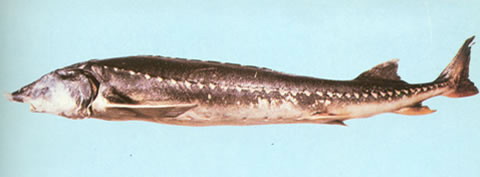| Acipenseridae (Sturgeons), subfamily: Acipenserinae |
| 560 cm TL (male/unsexed); max.weight: 1,000 kg; max. reported age: 80 years |
|
demersal; freshwater; brackish; marine; depth range 0 - 50 m, anadromous |
| Asia: Amur basin, ascending far up to the Argun, Shilka, and Onon. In the Amur Liman to the Amur estuary in the Sea of Okhotsk. Adults inhabit some lakes, like Orel Lake above Nikolaevsk. Also in the Ussuri and Sungari, China.
Four populations are recognized in the Amur River basin: one lives in the estuary and coastal brackish waters of the Sea of Okhotsk and Sea of Japan, second is found in the lower Amur, third in the middle Amur, and fourth in the lower reaches of the Zeya and Bureya rivers in the Russian river banks (Ref. 40142). Two ecological morphs are present in the estuary population, the 'freshwater' and the 'brackish' water forms (Ref. 40142). |
|
Dorsal spines (total): 0-0; Dorsal soft rays (total): 43-57; Anal spines: 0-0; Anal soft rays: 26-35. Gill membranes free from isthmus and broadly connected with each other. Barbels flat, attached on ventral side of snout. Body shields in 5 rows; dorsal shields 10 to 16, lateral 32 to 46 and ventral 8 to 12. |
| Adults inhabit rivers and lakes. Adults do not spawn every year but at least every other year. With increasing age, the spawning interval increases to three, four and more years (Ref. 593). Feed on invertebrates in the first year then switch to juveniles of pelagic fishes, e.g., Oncorhynchus keta, at age 3 to 4 yrs., kaluga feed on adult fishes (Ref. 40142). |
|
Critically Endangered (CR); Date assessed: 15 September 2019 (A2bd) Ref. (130435)
|
| harmless |
Source and more info: www.fishbase.org. For personal, classroom, and other internal use only. Not for publication.

